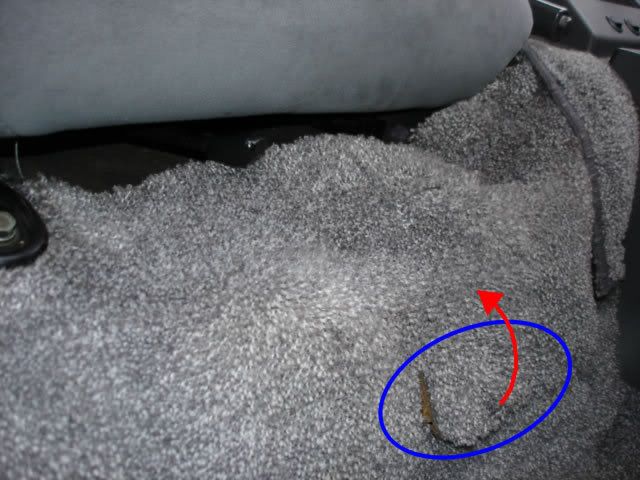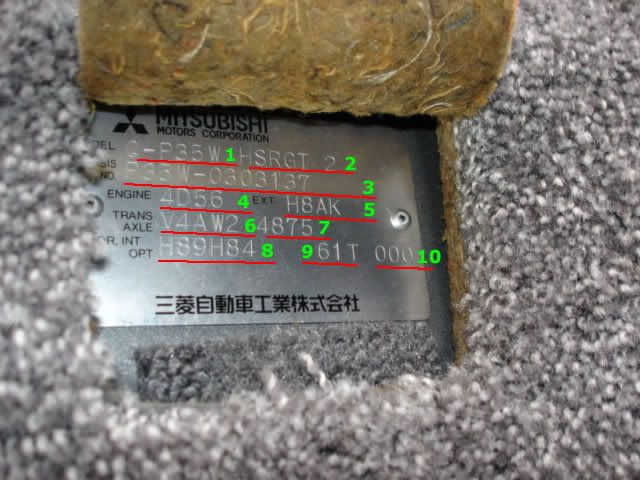Totally stolen (backed up? ;-)) from Mystery Machine's post on MDOCUK.
Anyone wishing to identify their Japanese Domestic Market Delica, here is the definitive way to do so. Some other markets made up their own naming conventions and/or used a VIN (looking at you, Australia), but much of this info will still be relevant.
Chassis Number:
Lift the small cover by the side of the drivers seat to reveal the full chassis number for your vehicle stamped into the floorpan


Build Plate:
The build plate is located under a flap of carpet just in front of the drivers seat. Lift the flap up to see the build plate

The plate has all the data about your vehicle and I have broken down the corresponding numbers (in green) as follows:

1: Vehicle model
2: Vehicle model extended specification
3: Chassis number (this should match the number stamped into the floorpan as above)
4: Engine model
5: Exterior code
6: Gearbox model
7: Differential (final drive) ratio
8: Paint code
9: Interior trim code
10: Factory fitted optional extras code
Breaking down the build plate:
1: Vehicle Model - each of the four digits stands for the following spec;
First digit: Vehicle
P = New model L300
Second digit: Chassis type
0 = 2WD standard body (high or low roof)
1 = 2WD long body (high or low roof)
2 = 4WD low roof
3 = 4WD high roof
4 = 4WD long body (high or low roof)
Third digit: Engine type
1 = 4G33 (1,400cc petrol)
2 = 4G32 (1,600cc petrol)
3 = 4G63, G63B (2,000cc petrol)
4 = 4G64, G64B (2,400cc petrol)
5 = 4D56 (2,500cc diesel)
6 = 4G92 (1,600cc petrol)
Fourth digit: Body type
V = Van
W = Minibus (7 or 8 seat)
2: Vehicle model extended specification
First digit: Body type II
G = Panel van low roof
H = Minibus (high or low roof)
J = Panel van high roof
None = Minibus/Window van
Second digit: Body type
S = 4 door (1 x sliding door)
L = 5 door (2 x sliding door)
Third digit: Transmission type
C = 4 speed manual (column shift)
Z = 5 speed manual (clumn shift)
N = 5 speed manual (floor shift)
R = Automatic transmission
Fourth digit: Trim code
U = GL (European vehicles)
U = XL (General export)
X = GLX (Including SE models Chamonix, Jasper)
P = GLS (Eurpean vehicles)
P = Exceed (All models)
G = Super Exceed (Home market models only)
None = DX
Fifth digit: Exhaust emission spec
A = A10
E = MPI (SOHC 16V)
T = Turbocharger
None = ECE R15-04
Sixth digit: Destination
6 = Europe
8 = Australia
W = Gulf countries
1D = Hong Kong
None = General export
Any other number (eg 2) = Home market only
So using the model code for my own car (P35W HSRGT 2) I have the following spec:
P = New L300
3 = 4WD high roof
5 = 4D56 engine
W = Minibus
H = Minibus
S = 4 Door
R = Automatic transmission
G = Super Exceed
T = Turbocharged
2 = Home market model
3: Chassis number - this should match the number stamped into the floorpan as above
4: Engine model
4G33 = 1,400cc petrol
4G32 = 1,600cc petrol
4G63 or G63B = 2,000cc petrol
4G64 or G64B = 2,400cc petrol
4D56 = 2,500cc diesel
4G92 = 1,600cc petrol
5: Exterior code
No data at this time for decoding this!
6: Gearbox model
R5M21 = 5 speed manual straight output
V5M21 = 5 speed manual with transfer box (part time 2 speed direct coupled)
R4AW2 = 4 speed auto straight output
V4AW2 = 4 speed auto with transfer box (part time 2 speed direct coupled)
7: Differential (final drive) ratio
Denotes the ratio of your final drive. L300's came with the following 4 ratios:
5.285
4.875
4.625
4.222
8: Paint code
Please look at this chart HERE for a break down of the paint codes. 2 tone vehicles will have 2 x 3 digit codes.
9: Interior trim code
No data at this time for decoding this!
10: Factory fitted optional extras code
No data at this time for decoding this!
Anyone wishing to identify their Japanese Domestic Market Delica, here is the definitive way to do so. Some other markets made up their own naming conventions and/or used a VIN (looking at you, Australia), but much of this info will still be relevant.
Chassis Number:
Lift the small cover by the side of the drivers seat to reveal the full chassis number for your vehicle stamped into the floorpan


Build Plate:
The build plate is located under a flap of carpet just in front of the drivers seat. Lift the flap up to see the build plate

The plate has all the data about your vehicle and I have broken down the corresponding numbers (in green) as follows:

1: Vehicle model
2: Vehicle model extended specification
3: Chassis number (this should match the number stamped into the floorpan as above)
4: Engine model
5: Exterior code
6: Gearbox model
7: Differential (final drive) ratio
8: Paint code
9: Interior trim code
10: Factory fitted optional extras code
Breaking down the build plate:
1: Vehicle Model - each of the four digits stands for the following spec;
First digit: Vehicle
P = New model L300
Second digit: Chassis type
0 = 2WD standard body (high or low roof)
1 = 2WD long body (high or low roof)
2 = 4WD low roof
3 = 4WD high roof
4 = 4WD long body (high or low roof)
Third digit: Engine type
1 = 4G33 (1,400cc petrol)
2 = 4G32 (1,600cc petrol)
3 = 4G63, G63B (2,000cc petrol)
4 = 4G64, G64B (2,400cc petrol)
5 = 4D56 (2,500cc diesel)
6 = 4G92 (1,600cc petrol)
Fourth digit: Body type
V = Van
W = Minibus (7 or 8 seat)
2: Vehicle model extended specification
First digit: Body type II
G = Panel van low roof
H = Minibus (high or low roof)
J = Panel van high roof
None = Minibus/Window van
Second digit: Body type
S = 4 door (1 x sliding door)
L = 5 door (2 x sliding door)
Third digit: Transmission type
C = 4 speed manual (column shift)
Z = 5 speed manual (clumn shift)
N = 5 speed manual (floor shift)
R = Automatic transmission
Fourth digit: Trim code
U = GL (European vehicles)
U = XL (General export)
X = GLX (Including SE models Chamonix, Jasper)
P = GLS (Eurpean vehicles)
P = Exceed (All models)
G = Super Exceed (Home market models only)
None = DX
Fifth digit: Exhaust emission spec
A = A10
E = MPI (SOHC 16V)
T = Turbocharger
None = ECE R15-04
Sixth digit: Destination
6 = Europe
8 = Australia
W = Gulf countries
1D = Hong Kong
None = General export
Any other number (eg 2) = Home market only
So using the model code for my own car (P35W HSRGT 2) I have the following spec:
P = New L300
3 = 4WD high roof
5 = 4D56 engine
W = Minibus
H = Minibus
S = 4 Door
R = Automatic transmission
G = Super Exceed
T = Turbocharged
2 = Home market model
3: Chassis number - this should match the number stamped into the floorpan as above
4: Engine model
4G33 = 1,400cc petrol
4G32 = 1,600cc petrol
4G63 or G63B = 2,000cc petrol
4G64 or G64B = 2,400cc petrol
4D56 = 2,500cc diesel
4G92 = 1,600cc petrol
5: Exterior code
No data at this time for decoding this!
6: Gearbox model
R5M21 = 5 speed manual straight output
V5M21 = 5 speed manual with transfer box (part time 2 speed direct coupled)
R4AW2 = 4 speed auto straight output
V4AW2 = 4 speed auto with transfer box (part time 2 speed direct coupled)
7: Differential (final drive) ratio
Denotes the ratio of your final drive. L300's came with the following 4 ratios:
5.285
4.875
4.625
4.222
8: Paint code
Please look at this chart HERE for a break down of the paint codes. 2 tone vehicles will have 2 x 3 digit codes.
9: Interior trim code
No data at this time for decoding this!
10: Factory fitted optional extras code
No data at this time for decoding this!
